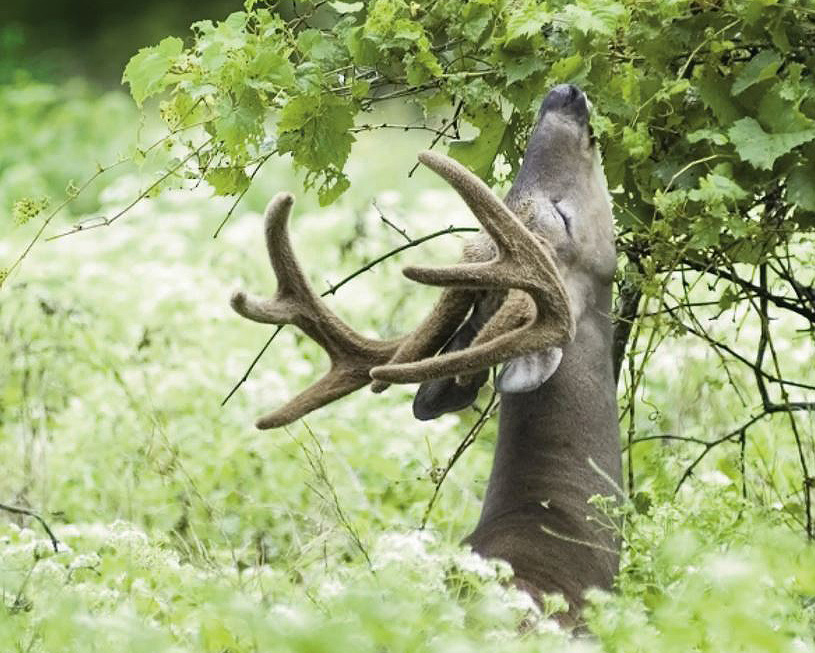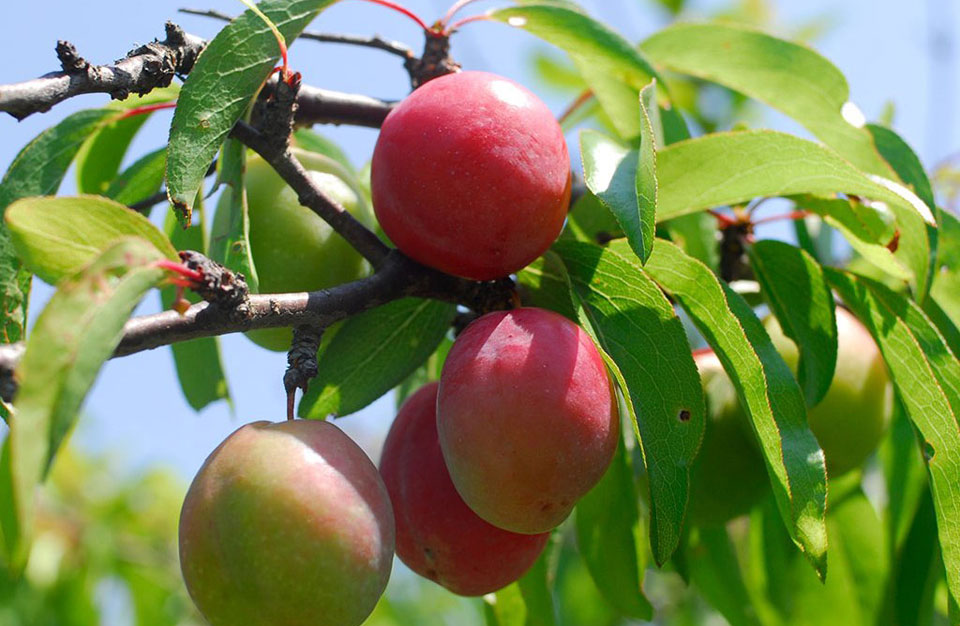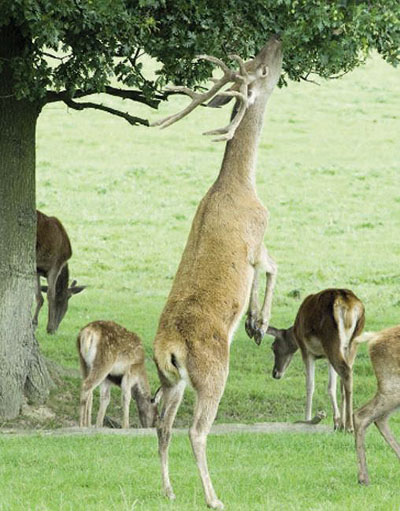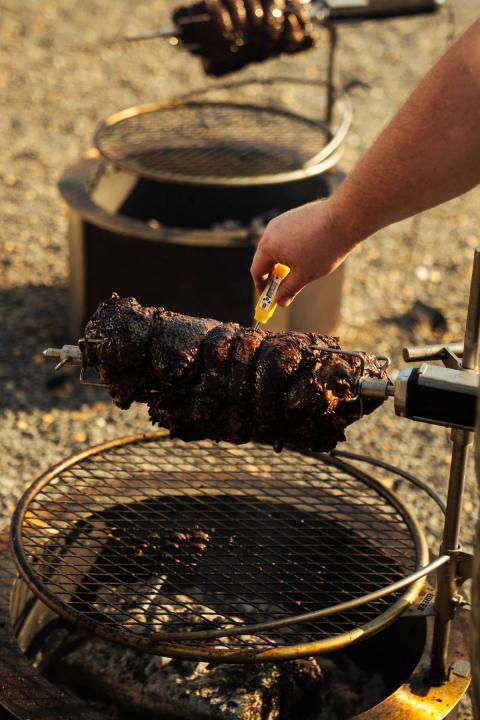Mark Thomas | Originally published in GameKeepers: Farming for Wildlife Magazine

Whitetail deer rely primarily on native plants for food. These plants can be divided into three main groups depending on the natural preference in which deer will consume them. First choice foods consist of succulent herbaceous plants like Alabama supplejack, greenbrier, blackberry, lespedeza, and strawberry bush. Second choice foods will start to be consumed when most of the preferred foods are depleted. They include species like American beautyberry and sumac and some of the woodier browse like red maple, red mulberry and flowering dogwood. Third choice foods are sometimes called emergency foods or stuffers and include sweetgum, blackjack oak, hickory, redbud and cedar. Whitetail deer preferentially browse the most preferred plants first, utilizing less desirable browse later until they are finally forced to browse on emergency/stuffer foods. If you lack herbaceous plants on your property and there is a browse line on your hardwoods and your cedars look like bonsai’s you have a serious whitetail deer overpopulation problem. This, sadly, occurs on many properties, especially in our State Parks and other areas where hunting is not allowed.
Think for a moment about the incredible amount of native plant materials that are consumed annually by whitetail deer. A single whitetail deer consumes between 8.25 and 12 pounds of plant material daily (green weight) or over 3,000 pounds a year. That does not sound like all that much does it? But let’s look at the annual consumption in a single state and then look at the entire whitetail deer range. Let’s say that the state of Alabama, for example, has approximately 2.8 million whitetail deer which each consume an average of 8.25 pounds of native plants daily or 3,011 pounds annually each. This equates to over 4.2 million tons of native plants required annually! That’s over 8 billion pounds of native plants consumed per year by whitetail deer in Alabama. This would equate to over 80 billion pounds of native plant food required in a decade if the deer population remained stable in Alabama and they only consumed native plants. There are approximately 32 million whitetail deer in the United States today. This population is considered super over abundant and is substantially higher than at any time since pre-recorded history. This is a testament to the hard work done by our State and Federal wildlife departments, hunters/sportsmen, private landowners, and wildlife conservation organizations like the Quality Deer Management Association. The whitetail deer population in the United States consumes approximately 132 million tons of plant foods daily or almost 50 billion tons annually! This equates to almost 100 billion pounds of foods consumed per year in the range of the whitetail deer in the United States. So, remember that number, 100 billion pounds per year, of plant material consumed by the whitetail deer herd in the United States – every year! In areas where whitetail deer are overpopulated, a significant reduction in overall plant biodiversity has occurred with some preferred plant species have been all but wiped out. And the whitetail deer population is still increasing rapidly in many states while it has stabilized in others.

What further complicates this is the fact that exotic, non-native and invasive plants are displacing our native plant communities at an alarming rate. We are currently losing over 4,500 acres per day of native plants in the United States due to the encroachment of exotic, non-native plants. This equates to over 1 and ½ million acres of native plants permanently lost per year. Over 7 million acres of native plant communities have already been displaced. Other wildlife species also consume native plants. Elk, mule deer, antelope and moose populations are all over 1 million animals each in North America. Moose, for example, consume an average of between 40 and 60 pounds of native plants per day. In Maine, for example, a population of around 35,000 moose consume around 2 million pounds of native plants per day. This equates to almost 1,000 tons per day, or over 325,000 tons of browse consumed each year by moose in Maine.

Whitetail deer are selective feeders. They choose native plants with considerable discrimination and, in actuality, consume a variety of different foods including acorns, vines, mushrooms, nuts, fruits, grasses, sedges, rushes, forbs, shrubs and twigs from trees. They tend to select succulent herbaceous plants first and turn to woody plant materials later. Food plots utilizing agricultural plants can be a source of highly nutritional food, as can agricultural fields. But, primarily, whitetail deer rely on native plants for the bulk of their diet. There is, however, little emphasis placed on enhancing native plant communities and little information available that explains exactly how to do it. Yet, it is relatively easy with long-lasting positive impacts usually at a fraction of the cost of establishing and maintaining agricultural food plots. Research has shown up to 40-fold increases in highly preferred native plants with protein contents of 26 to 32%, much higher than the 12-18% minimum required by whitetail deer. And, native plant communities are seldom impacted by drought. Selective herbicides like imazapyr actually release many native plants preferred by whitetail deer, wild turkey, and bobwhite quail. Other desirable native plants are promoted during forest management activities, especially clearcutting. It’s amazing how many hunters still do not understand how forest management activities improve whitetail deer food availability. Undoubtedly, the most food available on any hunting club is right in the middle of the most recent clearcut. Mid-rotation pine forests released with imazapyr also have an abundance of native plants preferred by whitetail deer, especially after thinning.
The next time you observe a whitetail deer browsing, remember that 100 billion pounds of native plants are consumed each year by whitetail deer in the United States. This is why so many of our State Parks that are overpopulated with deer and that do not allow hunting are essentially biological deserts with many deer starving to death each year. Follow the advice of your deer biologists when they suggest harvest strategies that reduce deer density by removing does. This will ensure that your deer population stays within the limits or carrying capacity of your habitat. This not only promotes healthier deer but also enhances the buck-doe ratio. Seek advice pertaining to native plant enhancement and learn how to identify preferred native plants utilized by whitetail deer in your area. Follow the Quality Deer Management Association (QDMA) guidelines on protecting yearling bucks from harvesting, thus shifting your population to older age class bucks.
Now is the time to evaluate your native plant component on your land. Do you have sufficient amounts of native plants to sustain your deer population? If not, have you added enough food plots to make up the difference, or to reduce the amount of native plants required? On some properties, the addition of supplemental feeding stations can also reduce the dependence on native plants and may help to increase the carrying capacity, allowing a larger deer herd to thrive.
To join the QDMA, call 1-800-209- 3337. And, start looking at forest management activities from the standpoint of how they can enhance native plants that are preferred by whitetail deer.
Mark Thomas is a Certified Wildlife Biologist and Forester, is President of Forestry/Wildlife Integration, LLC, and Chairman of the Board of the Quality Deer Management Association.






























